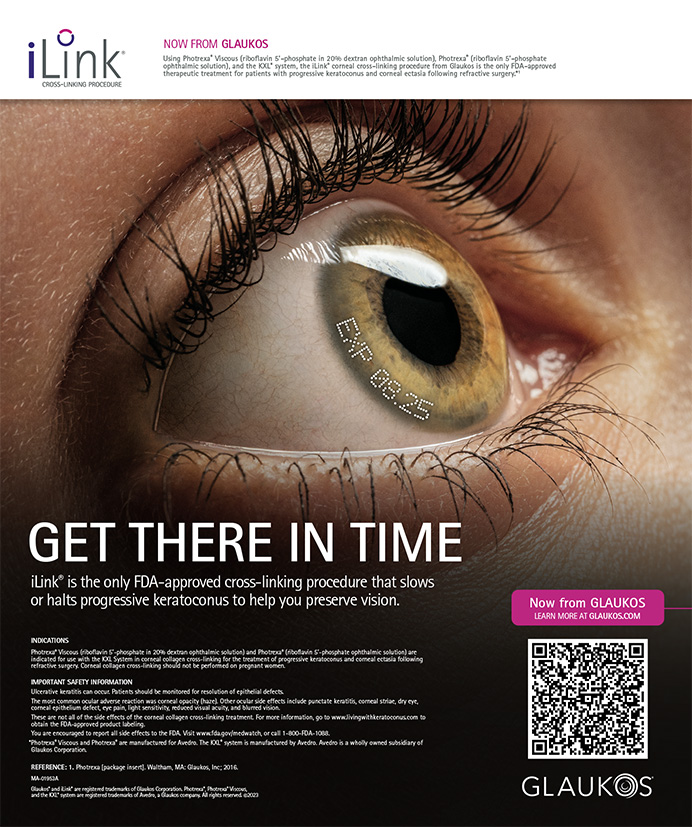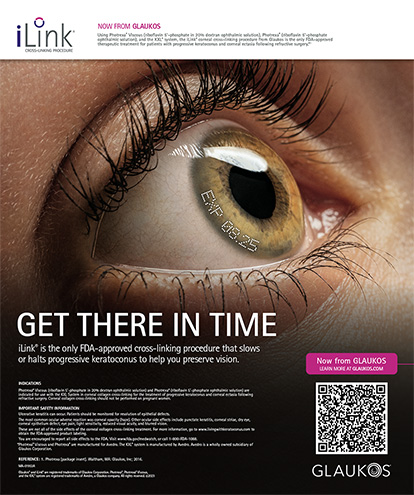The prophylaxis of postoperative endophthalmitis continues to generate controversy in light of purported antibiotic resistance to vancomycin and the pharmacodynamics of the drug. New fourth-generation fluoroquinolones may be more effective against both gram-positive and gram-negative bacteria, but their intracameral safety has not been established.1 This article describes the success of endophthalmitis prevention through routine, in-the-bag injection of vancomycin in 34,000 consecutive eyes.2
PERSONAL EXPERIENCEJames Gills, MD, of Tarpon Springs, Florida, initiated the use of antibiotics in irrigation solutions when he passed Garamycin (Schering-Plough Corporation, Kenilworth, NJ) 0.008g/mL through a 0.2-µm filter. My colleagues and I adopted this routine in 1985. Two years later, Dr. Gills began using vancomycin in the irrigation solutions (a practice we followed in 1988), and his incidence of endophthalmitis dropped from 0.2% to 0.003%.3 In 1990, we started using vancomycin as a bolus, rather than in the irrigating solutions. We inject 1mg of vancomycin in 0.1mL of BSS directly into the capsular bag behind the IOL. We have calculated the concentration of vancomycin in the anterior chamber to be 2.3mg/mL, but the actual concentration is much lower, because the drug is diluted by BSS added to repressurize the eye after the injection. Table 1 shows my protocol for the vancomycin mixture.
RESULTSWith Garamycin in the irrigating solution (1985 to 1987), the incidence of endophthalmitis at the Gimbel Eye Centre in Calgary, Alberta, Canada, ranged from 0.02% to 0.15%. This incidence remained relatively unchanged after vancomycin replaced Garamycin in the irrigating solution (1988 to 1989) (Figure 1). In an effort to improve on these results, I began in 1990 to inject vancomycin in the capsular bag, under the IOL, at the end of surgery. My reasoning was that endophthalmitis was more likely to develop in aqueous sequestered in the bag and that the vancomycin in that location would not wash out quickly. In a series of 33,818 consecutive eyes, only three have developed sterile endophthalmitis (an incidence rate of 0.009%) (Figure 2). All of these eyes regained a BCVA of 20/20 or better.
DISCUSSIONMost anterior segment surgeons feel some pressure to use broad-spectrum antibiotics during surgery. Nevertheless, both in vivo and in vitro studies have shown intracameral vancomycin to be effective for endophthalmitis prophylaxis,4-8 and a number of investigators have suggested that vancomycin used intracamerally can significantly reduce the risk of endophthalmitis.9-16 A survey conducted by the ASCRS showed that at least 35% of ophthalmic surgeons currently use intracameral antibiotics.17 Of the surgeons surveyed, 80% used vancomycin, and more than 40% used gentamicin.
The AAO-CDC Task Force on Vancomycin Prophylaxis in Ophthalmic Surgery recommends the prudent use of vancomycin in routine cataract surgery because of the potential for resistance to the drug and the lack of evidence for its effectiveness in preventing postoperative endophthalmitis.18 Recent in vivo and in vitro studies, however, have shown that vancomycin resistance is unlikely in cataract surgery and that the drug continues to be quite effective in inhibiting bacterial colony-forming units.9-12
To determine what constitutes a prudent use of vancomycin, one should consider the pharmacokinetics of the drug. Vancomycin is a time-dependent antibiotic and requires prolonged contact with microbes in the anterior chamber to be effective. When injected at 20µm/mL, the antibiotic has a half-life of approximately 2 hours.14,15 Because aqueous turnover occurs within 1 to 2 hours, vancomycin may be most effective if injected in the bag, under the IOL, with the optic well enclosed by the anterior capsule (Figure 3). This method of injection should result in a sustained release of vancomycin at therapeutic levels—important because vancomycin is relatively slow at killing organisms and may require 8 to 12 hours to reduce the inocula.
Howard V. Gimbel, MD, MPH, FRCSC, is Professor and Chairman, Department of Ophthalmology, Loma Linda University, Loma Linda, California. He is also Medical Director and Senior Surgeon at the Gimbel Eye Center. He states that he holds no financial interest in the products or companies mentioned herein. Dr. Gimbel may be reached at (909) 558-2182; hvgimbel@gimbel.com.
1. Gills JP. Filters and antibiotics in irrigating solution for cataract surgery. J Cataract Refract Surg. 1991;17:385.2. Gimbel HV, Sun R, DeBrof BM. Prophylactic intracameral antibiotics during cataract surgery: the incidence of endophthalmitis and corneal endothelial cell loss. Eur J Implant Refract Surg. 1994;6:280-285.
3. Gills JP. Pharmacodynamics of cataract surgery. In: Gills JP, ed. Cataract Surgery: The State of the Art. Thorofare, NJ: Slack Inc.; 1998: 19-26.
4. Olson RJ. Reducing the risk of postoperative endophthalmitis. Surv Ophthalmol. 2004;49(suppl 2):55-61.
5. Busbee BG. Advances in knowledge and treatment: an update on endophthalmitis. Curr Opin Ophthalmol. 2004;15:232-237.
6. Mamalis N, Kearsley L, Brinton E. Postoperative endophthalmitis. Curr Opin Ophthalmol. 2002;15:14-16.
7. Benz MS, Scott IU, Flynn HW, et al. Endophthalmitis isolates and antibiotic sensitivities: a 6-year review of culture proven cases. Am J Ophthalmol. 2004;137:38-42.
8. Gordon YJ. Vancomycin prophylaxis and emerging resistance: are ophthalmologists the villains? The heroes? Am J Ophthalmol. 2001;131:371-376.
9. Seppala H, Al-Juhaish M, Jarvinen H, et al. Effect of prophylactic antibiotics on antimicrobial resistance of viridans streptococci in the normal flora of cataract surgery patients. J Cataract Refract Surg. 2004;30:307-315.
10. Ta CN, Chang RT, Singh K, et al. Antibiotic resistance patterns of ocular bacterial flora: a prospective study of patients undergoing anterior segment surgery. Ophthalmology. 2003;110:1946-1951.
11. Libre PE, Della-Latta P, Chin NX. Intracameral antibiotic agents for endophthalmitis prophylaxis: a pharmacokinetic model. J Cataract Refract Surg. 2003;29:1791-1794.
12. Sobaci G, Tuncer K, Tas A, et al. The effect of intraoperative antibiotics in irrigating solutions on aqueous humor contamination and endophthalmitis after phacoemulsification surgery. Eur J Ophthalmol. 2003;13:773-778.
13. Das T, Sharma S, Muralidhar AV; Endophthalmitis Research Group. Effect of vancomycin on Staphylococcus epidermidis adherence to poly(methyl methacrylate) intraocular lenses. J Cataract Refract Surg. 2002;28:703-708.
14. Souli M, Kopsinis G, Kavouklis E, et al. Vancomycin levels in human aqueous humour after intravenous and subconjunctival administration. Int J Antimicrob Agents. 2001;18:239-243.
15. Mendivil Soto A, Mendivil MP. The effect of topical povidone-iodine, intraocular vancomycin, or both on aqueous humor cultures at the time of cataract surgery. Am J Ophthalmol. 2001;131:293-300.
16. Tipperman R. Pharmacologic considerations for cataract surgery. Curr Opin Ophthalmol. 2004;15:51-55.
17. Masket S. Preventing, diagnosing and treating endophthalmitis (guest editorial). J Cataract Refract Surg. 1998;24:725-726.
18. The American Academy of Ophthalmology information statements page. The prophylactic use of vancomycin for intraocular surgery. A joint statement of the American Academy of Ophthalmology and the Centers for Disease Control and Prevention. Available at: http://www.aao.org/aao/education/library/information/vancomycin.cfm. Accessed January 14, 2005.


